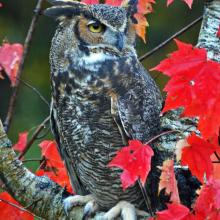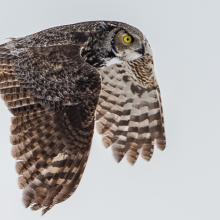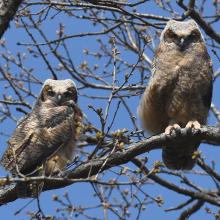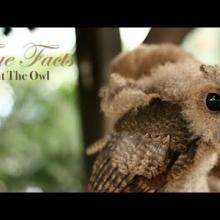

Join BirdNote tomorrow, November 30th!
Illustrator David Sibley and actor H. Jon Benjamin will face off in the bird illustration battle of the century during BirdNote's Year-end Celebration and Auction!
Young birds leave their nests in different ways. Some shuffle tentatively along the nearest branch and practice flapping their wings, while others take the "big leap." Which path they take depends upon their species and the location of the nest. Young Great Horned Owls clamber out of the nest to nearby branches where they flap their wings and make short, cautious flights, while they continue to be fed by their parents.
BirdNote®
How Nestlings Leave the Nest
Written by Frances Wood
This is BirdNote!
In June, when birdsong is on the wane, many baby birds leave the nest. Some shuffle tentatively along the nearest branch, while others take the “big leap.”
Young Great Horned Owls clamber out of their nest to nearby branches where they perch, flap their wings, and beg to be fed by their parents.
[Young Great Horned Owl vocalizations; adults in background]
The young owls practice flying by taking short, cautious flights to close-by branches or neighboring trees before they depart the nesting area.
[Sounds of Glaucous-winged gulls and a colony of Common Murres]
Young seabirds, in their nests on high rocky cliffs, often can’t fly. To launch themselves, they tumble off the cliff to land on the water below. Built to bounce, the chicks pop up and swim close to their parents who continue to feed them. But oh! What a first step!
The Marbled Murrelet is a small, endangered seabird that nests in old coastal forests on the West Coast. It has a risky exit strategy! From its nest high in a tree, the chick must make its first solo flight all the way to the sea, often 10 or 20 miles away.
[Keer calls of the Marbled Murrelet]
For BirdNote, I’m Michael Stein.
###
Calls of the owls, gulls, and murrelets provided by The Macaulay Library of Natural Sounds at the Cornell Lab of Ornithology, Ithaca, New York. Young Great Horned Owls recorded by D.T. Spaulding; Adult Great Horned Owls by R.W. Fish; Glaucous-winged Gulls by Grace M. Bell; Marbled Murrelet by K.S. Nelson.
The colony of Common Murres was recorded by Gerrit Vyn; chick and parent recorded by T.G. Sander.
Producer: John Kessler
Executive Producer: Chris Peterson
© 2013 Tune In to Nature.org June 2013/2021 Narrator: Michael Stein
ID#061405hatchKPLU fledge-01b-2009-06-09-MS-









